39-1 For the growth of brain
○Unnecessary connections of nerve cells in the human brain is removed rapidly when it comes to 11-year-old. Then, the signal is transmitted earlier by nerve becomes thick (development of myelin sheath), so that the brain becomes possible to perform processing efficiently.
○Myelination of the prefrontal cortex continues actively until about 25 years old.
○Brain can change by training. = It is possible to change your character.
This is the method.
1. Positive thinking = Shake off the negative thoughts.
2. Do it positive.
3. Control your life.
4. Continue it easy.・・・Because it’s not easy.
【Reference】Elaine Fox
https://www.youtube.com/watch?v=S-dIiOugUJE
☆The brain is the growing connectome!
... The brain is not only the fact that the most advanced structures in the universe, even it grow!
A connectome[1] [2] is a comprehensive map of neural connections in the brain, and may be thought of as its "wiring diagram". More broadly, a connectome would include the mapping of all neural connections within an organism's nervous system.
The production and study of connectomes, known as connectomics, may range in scale from a detailed map of the full set of neurons and synapses within part or all of the nervous system of an organism to a macro scale description of the functional and structural connectivity between all cortical areas and subcortical structures. The term "connectome" is used primarily in scientific efforts to capture, map, and understand the organization of neural interactions within the brain.
☆Comparable to the brain is growing artificial intelligence(GAI).
☆ Growing artificial intelligence(GAI) is a complex of brain and artificial intelligence.
☆Because the brain is the most advanced structures in the universe.
☆ One human role is to pump GAI into the universe!
39-2 Features of the brain
○Features of the brain is learning and creativity.
○In the cerebral cortex, there are functions of Bayesian network, Self-organizing map, Independent component analysis, Reinforcement learning. [3]
※Bayesian network:It is a technique for making inferences based on probabilistic efficiently. And it acts similar to intuition, which is one of the functions of the brain. It is a technology that is the key to understanding of information processing principles of the brain. [3]
・It has based on Bayes' theorem, which was discovered in 1763 by British pastor Thomas Bayes (1702 (?) - 1761).
※Self-organizing map:It is a neural network algorithm of unsupervised proposed by T. Kohonen.
※Independent component analysis:It is a calculation method for separating a signal of multivariate into additive components. A typical application is the sound source separation to extract the voice of a specific person from a plurality of human conversation, which was recorded in a room.
※Reinforcement learning:It is learning to adapt to the environment through trial and error.
39-3 Cerebral cortex
○ The cerebral cortex is the cerebrum's (brain) outer layer of neural tissue. The human cerebral cortex is 2 to 4 millimetres thick. The cerebral cortex plays a key role in memory, attention, perception, awareness, thought, language, and consciousness. [4]
○The most recent part of the cerebral cortex to develop in the evolutionary history of mammals is the neocortex (also called isocortex), which differentiated into six horizontal layers; the more ancient part of the cerebral cortex, the hippocampus, has at most three cellular layers. [4]
○ In the human brain more than two-thirds of the cerebral cortex is buried in the sulci(groove or fissure). [4]
○A Brodmann area is a region of the cerebral cortex, in the human or other primate brain, defined by its cytoarchitecture, or histological structure and organization of cells. He divided the human cerebral cortex into 52 areas (fields).
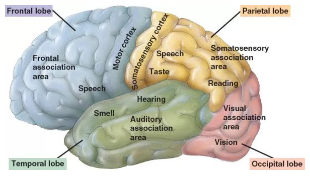
※Cerebral cortex [5]
○About 50 areas are connected to each other to create a hierarchical network. [6]
(In the case of visual stimulation: primary visual cortex → secondary visual cortex → hippocampus • prefrontal cortex)
○The upper level of the hierarchy represents more abstract information. [6]
○Individual areas are aggregates of macro columns, and macro columns are collections of mini columns. [6]
・Macro columns:500 μm in diameter, 1 million pieces
・Mini column:50 μm, 100 million pieces
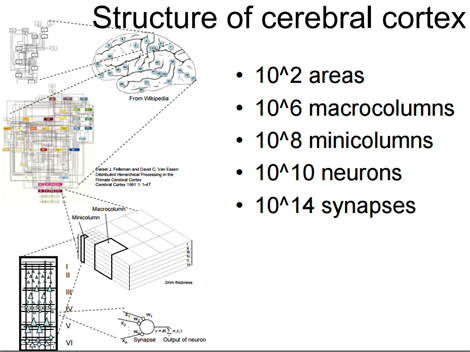
※Structure of cerebral cortex [7]
39-3-1 Frontal lobe
○The frontal lobe contains most of the dopamine-sensitive neurons in the cerebral cortex. The dopamine system is associated with reward, attention, short-term memory tasks, planning, and motivation. [8]
○The left frontal lobe performs logical matters such as letters and words. [9]
○The right frontal lobe instantly intuitively and comprehensively recognizes and judges external information. [9]
○Suppression of emotion, language and motor function change with frontal lobe lesions.
39-3-2 Limbic system
○ Limbic system is a collective term such as amygdala, hippocampus, mammiliary body.
○ The role of limbic system is memory (short-term memory and long-term memory), emotion, motivation and intuition.
○ Limbic system has a strong relationship with the olfactory function.
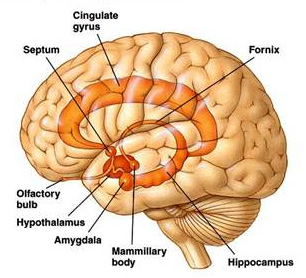
※ Limbic system [10]
○The amygdala body acts excessively and stress hormone (cortisol) is released in response to stress, such as strong and long anxiety, fear and tension. [11]
○By cortisol, hippocampal neurons are destroyed (inhibiting neurogenesis) and the hippocampus is atrophied. [12] In posttraumatic stress disorder (PTSD) and depression patients, hippocampal atrophy is confirmed. [13]
○The stronger the stress received as a child, the more it tends to become the amygdala become bigger. When the amygdala body grows larger, it responds to small stress. [14]
○Alzheimer disease (AD) develops from atrophy of the hippocampus and causes atrophy (protein aggregation) of a part of the frontal lobe. [15]
<Countermeasure>
○Coping: Repeating measures while firmly recognizing stress can activate the frontal lobe and suppress the activity of the amygdala. [16] [17]
○Recovery of the hippocampus and reduction of the amygdala have been confirmed even in mindfulness that aims consciousness of the body and respiratory sense without thinking about the past and the future. [17] [18]
○The action of genes secreting nerve growth factor "VGF" is activated by exercise. [19]
○Oxytocin secreted from the pituitary gland by massage also calms the excitement of the amygdala. [20]
○Nucleus accumbens produces GABA, a transmitter of "motivation".[21]
※The nucleus accumbens is often described as one part of a cortico–basal ganglia–thalamic loop.
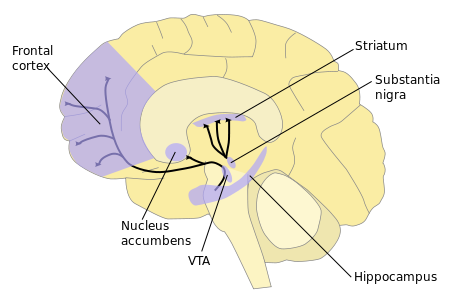
※Nucleus accumbens [22]
39-3-3 Oxytocin, Endorphins, Dopamine
○As far as the basic emotional mechanism is concerned, there is no big change in humans and other primates.
39-3-3-1 The effect of three hormones
○Oxytocin
・The positive effects of upping oxytocin are most likely because oxytocin supports your brain's serotonin, the feel good neurochemical. Many serotonin producing neurons also have oxytocin receptors; when oxytocin is released, serotonin gets a boost too. Plus, oxytocin also calms the reactivity of the amygdala, the fear center of your brain, and strengthens its communication with brain circuits that help you control emotions. [23]
○Endorphins
・Endorphins are sedative and analgesic hormone that acts on the brain's reward system 6.5 times as much as morphine. Endorphins are the abbreviation of endogenous morphine, named endorphin, because it causes the same action as morphine.
・Endorphins are secreted at important parts of the whole body.
・Endorphins normalize autonomic nerves.
・In addition, endorphins increase T cells, B cells and NK cells (natural killer cells), which are immune cells.
○Dopamine
・Dopamine is involved in the remuneration system, and plays an important role in motivation, learning, memory, etc. [24] In extreme terms, humans live for the purpose of secretion of dopamine.
・Dopamine has a role of suppressing motor nerves. (Acetylcholine promotes excitement)
39-3-3-2 Where are the hormons secreted from?
○Oxytocin and endorphins are secreted from the hypothalamus.
○Dopamine is secreted from the substantia nigra dense part(A9) and the ventral donning field(A10).
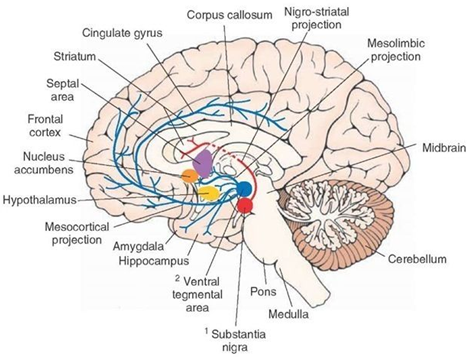
※Dopaminergic neurons and their projections [25]
39-3-3-3 Hormone deficiency
○ Oxytocin • Endorphin deficiency:Increased aggression and increased anxiety
○Dopamine deficiency:Powerless and lethargic. Declining concentration, attention and memory. The reaction gets dull. ・・・Same as symptoms of depression
• In patients with Parkinson's disease, nigral (A9) dopamine neurons die, resulting in less dopamine released in the striatum causing symptoms such as immobility, stasis and tremor.
・In the case of Parkinson's disease, only dopamine neurons are almost dead and other neurons remain normal.
39-3-3-4 Hormone excess
○Oxytocin excess:The receptor of oxytocin decreases, resulting in increased aggression and anxiety.
○Dopamine excess:Hallucination, delusions, paralysis, obsessive-compulsive disorder, overeating, sometimes aggressive ・・・Same as withdrawal symptoms of stimulants.
• Tobacco and stimulants such as narcotics, cocaine, amphetamine increase dopamine and become addictive.
39-3-3-5 How to increase your hormone levels naturally
1. Eat high quality protein:Animal products, soybeans (more than 2 packs of tofu or one pack of natto per day)
2. Exercise
3. Bathing at 40 ° C (Caution:If you enter a bath of 42 ° C or more for more than 10 minutes, your blood becomes sticky.)
4. Get adequate sleep.
5. Win and profit
6. Be praised.
7. Massage
8. Physical touch:Hugs, kisses, and cuddling, etc
9. Give and Get creative:In satisfying the physical needs, the suppressing substances trying to suppress it are released. However, when realizing the spiritual desire such as "love for humanity" "meditation" "art" "self-enhancement", the three hormones continue to be released without being suppressed.
○Dopamine is secreted from dopamine nervous system (aka A10 nervous system) by endorphin suppressing GABA neurons in ventral tegmental area.
○Since endorphins are present in unicellular organisms, they are considerably older than oxytocin.
39-3-3-6 Inhibition of 3 hormonal secretion
○The amount of secretion of endorphin decreases due to stress and fatigue, excitation hormone noradrenaline is secreted instead.
○Stress inhibits the secretion of dopamine.
39-4 Situation of brain science research
○BRAIN initiative [26]
The BRAIN Initiative (Brain Research through Advancing Innovative Neurotechnologies, also referred to as the Brain Activity Map Project) is a proposed collaborative research initiative announced by the Obama administration on April 2, 2013, with the goal of mapping the activity of every neuron in the human brain. Based upon the Human Genome Project, the initiative has been projected to cost more than $300 million per year for ten years.
○Human Brain Project [27]
The Human Brain Project is a large 10-year scientific research project, established in 2013, coordinated by Henry Markram (École polytechnique fédérale de Lausanne) and largely funded by theEuropean Union, which aims to provide a collaborative informatics infrastructure and first draft rodent and human whole brain models within its 10 year funding period.The project is based inGeneva, Switzerland and was initiated by Markram.
39-5 Immunity and Memory
○Immunity:To escape disease with aware of the pathogens and cancer cells in vivo.
Plague (disease) by infection with pathogenic bacteria can be resistant, and we can be difficult to disease.
○ There is two type of immunity, the innate immunity of almost all organisms and the adaptive immunity of vertebrate.
○Innate immunity that leukocytes (phagocytes) eat pathogens are innately equipped.
→ The innate immune system can not function adequately against new viruses.
○The adaptive immunity:lymphocytes(specific leukocytes) produce acquired antibodies against viral and other pathogens (antigens) to suppress the activity of the virus.
○In lymphocyte balls, the information for production of antibodies (proteins) does "memory" into DNA. This is called immunological memory.
○Dr. Susumu Tonegawa won the Nobel Prize in this immunization research field (elucidation of the hereditary principle of antibody generation) in 1987.
○Immunological memory and cerebral memory work by the same structure, and both of immunological systems (lymphatic system) and nervous systems are everywhere spread in the whole body.
【References】
1. Connectome - Wikipedia
2. TED/Sebastian Seung: I am my connectome
3. 産業技術総合研究所 > 一杉裕志 > 脳とベイジアンネット > 脳とベイジアンネットFAQ( 2011-05-26 更新)(Japanese)
4. Cerebral cortex - Wikipedia
5. JEFFREY STERLING “Straight, No Chaser: Brain Health – How Your Brain Works”at JEFFREY STERLING.com 20160712
https://jeffreysterlingmd.com/tag/cerebral-cortex/
6.Yuuji Ichisugi”The Cerebral Cortex and Bayesian Networks”at Journal of the Robotics Society of Japan 20110715
https://www.jstage.jst.go.jp/article/jrsj/29/5/29_5_412/_article
7.Yuuji Ichisugi, Haruo Hosoya, "Computational Model of the Cerebral Cortex that Performs Sparse Coding Using a Bayesian Network and Self-Organizing Maps"
https://staff.aist.go.jp/y-ichisugi/besom/20101122iconip.pdf
8.Frontal lobe - Wikipedia
9. “Frontal lobes”at CENTRE FOR NEURO SKILLS
10. Limbic System/The Neurophysiology of Emotions
11. Effects of stress on memory - Wikipedia
12.Cheryl D.Conrad” Chronic Stress-Induced Hippocampal Vulnerability: The Glucocorticoid Vulnerability Hypothesis”at US National Library of Medicine
https://translate.google.co.jp/translate?hl=ja&sl=en&u=https://www.ncbi.nlm.nih.gov/pmc/articles/PMC2746750/&prev=search
13. Christian Schmahl, MD, Kevin Berne, MD, Annegret Krause, MA, Nikolaus Kleindienst, PhD, Gabriele Valerius, PhD, Eric Vermetten, MD, and Martin Bohus, MD” Hippocampus and amygdala volumes in patients with borderline personality disorder with or without posttraumatic stress disorder”at US National Library of Medicine
https://translate.google.co.jp/translate?hl=ja&sl=en&u=https://www.ncbi.nlm.nih.gov/pmc/articles/PMC2702446/&prev=search
14. Christopher Bergland”The Size and Connectivity of the Amygdala Predicts Anxiety”at Psychology Today 20131120
https://www.psychologytoday.com/blog/the-athletes-way/201311/the-size-and-connectivity-the-amygdala-predicts-anxiety
15. “Alzheimer's Disease” at UCSF Memory and Aging Center
https://translate.google.co.jp/translate?hl=ja&sl=en&u=http://memory.ucsf.edu/education/diseases/alzheimer&prev=search
16. “Health and Behavior: The Interplay of Biological, Behavioral, and Societal Influences.”
https://translate.google.co.jp/translate?hl=ja&sl=en&u=https://www.ncbi.nlm.nih.gov/books/NBK43737/&prev=search
17.No.61 Self Control
18. Britta K. Hölzel, James Carmody, Karleyton C. Evans, Elizabeth A. Hoge, Jeffery A. Dusek, Lucas Morgan, Roger K. Pitman, and Sara W. Lazar “Stress reduction correlates with structural changes in the amygdala”at NCBI 201003
https://www.ncbi.nlm.nih.gov/pmc/articles/PMC2840837/
19. Ozlem Bozdagi,1 Erin Rich,1 Sophie Tronel,1 Masato Sadahiro,1 Kamara Patterson,1 Matthew L. Shapiro,1,2Cristina M. Alberini,1 George W. Huntley,1 and Stephen R. J. Salton “The Neurotrophin-Inducible Gene Vgf Regulates Hippocampal Function and Behavior Through a BDNF-Dependent Mechanism”at NCBI 20100211
https://www.ncbi.nlm.nih.gov/pmc/articles/PMC2820295/
20. Sobota R, Mihara T, Forrest A, Featherstone RE, Siegel SJ “Oxytocin reduces amygdala activity, increases social interactions, and reduces anxiety-like behavior irrespective of NMDAR antagonism.”at NCBI 201508
https://www.ncbi.nlm.nih.gov/pubmed/26214213
21. Nucleus accumbens - Wikipedia
22. Jon Lieff “Pleasure Circuits in the Brain”at Searching for the Mind 20150705
23.Debbie Hampton “Why Spending Time With Friends Boosts Your Oxytocin”at mindbodygreen
24. Daphna Shohamy and R. Alison Adcock” Dopamine and adaptive memory”
25. “Caudate Nucleus” at Pinterest • A világ legnagyobb ötletgyűjteménye
https://hu.pinterest.com/explore/caudate-nucleus/
26.BRAIN initiative
27. Human Brain Project
【Change log】
20170416 Add a photo
20180212 Delete Alzheimer's preventive food
0 件のコメント:
コメントを投稿